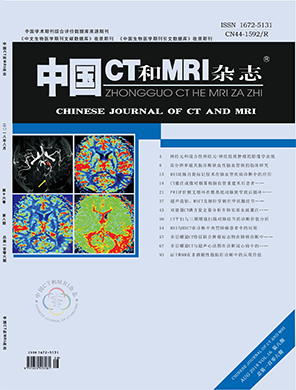摘要
目的 探讨1.0T MRI与64层MSCT 在中低位直肠癌术前T分期诊断价值。方 法 收集我院93例经手术病理证实中低位 直肠癌及肿瘤分期患者的临床资料,根 据术前诊断方式分为MRI组与MSCT组,比 较两组术前诊断结果及T分期,并与术 后病理结果比较,评估两者诊断价值。 结果 MSCT各种分期总准确率为65.1% (28/43),显著低于MRI检查的总准确率 88.0%(44/50)(P<0.05);MSCT诊断为 T1-2的灵敏度、准确率依次为64.3%、 86.0%,Kappa为0.629,T3诊断效能依 次是62.5%、86.0%、0.539,T3诊断 效能依次是66.7%、88.4%、0.634。 1.0T MRI T1-2诊断效能依次是80.0%、 86.0%、0.706,T3诊断效能依次是 86.2%、90.0%、0.799,T4诊断效能依 次是75.0%、96.0%、0.728。结论 1.0T MRI与64层MSCT均可用于中低位直肠癌术 前T分期,两者诊断价值相当,但MRI诊 断效能稍高于MSCT,尤其是区分T2、T3 期肿瘤。
Objective To evaluate the value of 1.0T MRI and 64 slice MSCT in preoperative T staging of middle and low rectal cancer. Methods The clinical data of 93 patients with pathologically confirmed middle and low rectal cancer were collected. They were divided into MRI group and MSCT group according to the preoperative diagnostic method.Results of preoperative diagnosis and T staging were compared between the two groups, and the results were compared with postoperative pathological results. The diagnostic value of the two methods was evaluated. Results The total accuracy of MSCT for different stages was significantly lower than that of MRI [65.1% (28/43) vs 88.0% (44/50)] (P<0.05). The sensitivity, accuracy and Kappa value of MSCT diagnosis for T1-2 were 64.3%, 86.0% and 0.629, respectively. The diagnostic efficiencies of T3 were 62.5%, 86.0% and 0.539, respectively, while the diagnostic efficiencies of T4 were 66.7%, 88.4% and 0.634, respectively. The diagnostic efficiencies of 1.0T MRI for T1-2 were 80.0%, 86.0% and 0.706, respectively. The diagnostic efficiencies of T3 were 86.2%, 90.0% and 0.799, respectively, while the diagnostic efficiencies of T4 were 75.0%, 96.0% and 0.728, respectively. Conclusion Both of 1.0T MRI and 64 slice MSCT can be used for preoperative T staging of middle and low rectal cancer. Their diagnostic value is similar, but the diagnostic efficiency of MRI is slightly higher than that of MSCT, especially in differential diagnosis of tumors at stage T2 and T3.
【关键词】MRI;MSCT;中低位直肠癌; T分期;诊断效能
【中图分类号】R735.3+7
【文献标识码】A
【DOI】10.3969/j.issn.1672-5131.2018.08.040
前言
结直肠癌属全球性疾病,其发病率、病死率位居世界第3位,据 WHO显示,全球每年新发患者人数在120万以上,死万人数仅60万,我 国结直肠癌发病的主要特点是直肠癌所占比例高,约为60%,其中中 低位直肠癌占60%~75%,与人们的饮食、生活息息相关[1-2]。有关中低 位直肠癌的治疗方式众多,经肛门局部切除术对患者肿瘤浸润度、直 径、距肛缘距离等要求较高;中低位直肠癌的新辅助治疗多针对T3与 T4肿瘤,可有效降低肿瘤局部复发率、提高保肛率[3];腹腔镜下全直 肠系膜切除术3年存活率较高,且有效控制局部复发率[4]。不同术式对 不同分期患者的治疗效果并不一致,且患者预后不良的主要原因之一 就是错过最佳诊疗时机,病程多半发展至中晚期,无论采取何手术措 施,都依靠术前疾病诊断及疾病分期[5-6]。MRI与MSCT均可用于直肠癌 术前评估,本研究旨在分析两种不同检查方法的优缺点及成像特点, 以供临床分析MRI与MSCT在中低位直肠癌中的诊断意义,现报告如下。
中国CT和MRI杂志
第16卷, 第 8 期
2018年08月

相关文章